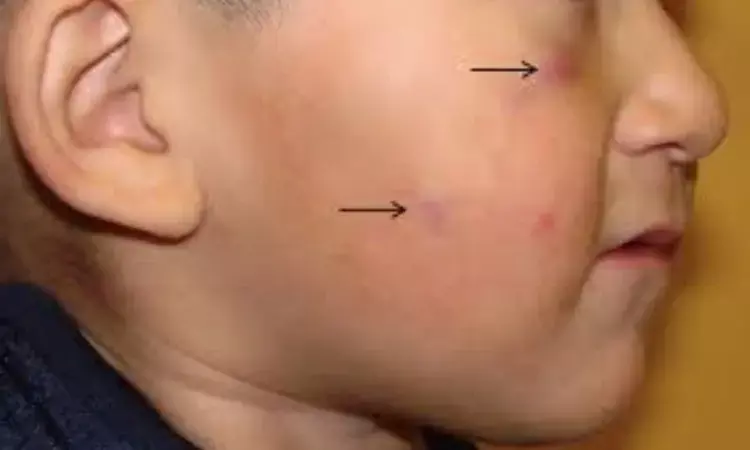- Home
- Medical news & Guidelines
- Anesthesiology
- Cardiology and CTVS
- Critical Care
- Dentistry
- Dermatology
- Diabetes and Endocrinology
- ENT
- Gastroenterology
- Medicine
- Nephrology
- Neurology
- Obstretics-Gynaecology
- Oncology
- Ophthalmology
- Orthopaedics
- Pediatrics-Neonatology
- Psychiatry
- Pulmonology
- Radiology
- Surgery
- Urology
- Laboratory Medicine
- Diet
- Nursing
- Paramedical
- Physiotherapy
- Health news
- Fact Check
- Bone Health Fact Check
- Brain Health Fact Check
- Cancer Related Fact Check
- Child Care Fact Check
- Dental and oral health fact check
- Diabetes and metabolic health fact check
- Diet and Nutrition Fact Check
- Eye and ENT Care Fact Check
- Fitness fact check
- Gut health fact check
- Heart health fact check
- Kidney health fact check
- Medical education fact check
- Men's health fact check
- Respiratory fact check
- Skin and hair care fact check
- Vaccine and Immunization fact check
- Women's health fact check
- AYUSH
- State News
- Andaman and Nicobar Islands
- Andhra Pradesh
- Arunachal Pradesh
- Assam
- Bihar
- Chandigarh
- Chattisgarh
- Dadra and Nagar Haveli
- Daman and Diu
- Delhi
- Goa
- Gujarat
- Haryana
- Himachal Pradesh
- Jammu & Kashmir
- Jharkhand
- Karnataka
- Kerala
- Ladakh
- Lakshadweep
- Madhya Pradesh
- Maharashtra
- Manipur
- Meghalaya
- Mizoram
- Nagaland
- Odisha
- Puducherry
- Punjab
- Rajasthan
- Sikkim
- Tamil Nadu
- Telangana
- Tripura
- Uttar Pradesh
- Uttrakhand
- West Bengal
- Medical Education
- Industry
Oral macrolides effective for treating children with aseptic facial granuloma: Study

Germany: A recent study published in Pediatric Dermatology has shown the effectiveness of oral macrolides for the treatment of patients with aseptic facial granuloma (AFG).
In the retrospective case series involving 12 children with aseptic facial granuloma, treatment with oral macrolides (roxithromycin or erythromycin) resulted in the healing of the lesions within a mean treatment time of 5.25 months with no recurrences, and the treatment was well-tolerated.
Aseptic facial granuloma is a rare pediatric disorder with the characteristics of painless inflammatory nodules localized to the eyelids or cheeks. Evidence has shown its association with granulomatous rosacea in childhood as some studies reported at least two clinical signs of rosacea, such as erythema, flushing, telangiectasias, papules and pustules in 42% and ocular involvement in 32% of 38 patients with AFG.
Aseptic facial granuloma remains a diagnostic and therapeutic challenge due to the limited case series reported in the literature. Daniela Lenders, Department of Dermatology, University of Tuebingen, Tuebingen, Germany, and colleagues performed a single centre, retrospective case series in the Department of Dermatology in Tuebingen, Germany, involving children diagnosed with AFG from 2015 to 2022.
Patients were treated orally with either roxithromycin 7.5 mg/kg or erythromycin 30–50 mg/kg daily. Ten dermatologists estimated the intensity of erythema, size of the lesion(s), and induration of the nodule(s) by photo documentation before the start of the therapy and after three to 6 months of the therapy.
The scoring system comprised the following parameters: 0: clear, 1: almost clear, 2: mild, 3: moderate, and 4: severe. A minimal 50% reduction of the respective score was considered a treatment response.
From 2015 to 2022, 20 patients were diagnosed with AFG. Due to insufficient follow-up data, eight patients were excluded. Twelve patients were included comprising 58% males. Eleven patients were treated with erythromycin and one patient was treated with roxithromycin orally. The mean treatment duration was 5.25 months. The mean age was 5.5 years.
75% of the patients showed signs of rosacea, namely erythema, pustules or papules. 16% had telangiectasias on the eyelids as well, and 33% had associated recurrent blepharitis, conjunctivitis, or chalazia. The mean duration of the lesions before starting therapy was 8.25 months.
The study led to the following findings:
• The mean erythema score was 2.81 before treatment and 0.84 after treatment, resulting in an improvement of erythema score of 70.1%.
• There was a reduction in the induration score from 2.7 to 0.61, which is a 77.4% score reduction under therapy.
• There was a decrease in the size score from 2.61 to 0.90, resulting in a 65.5% score reduction.
• Patients with an early therapy start within 8 months from lesion onset to therapy initiation (n = 7 patients) were analyzed to assess for the possibility of spontaneous resolution. The mean total persistence of lesions in this group was 7.7 months (range: 5–10 months).
• While treatment was generally well tolerated, 16% of patients developed diarrhoea and one stopped therapy early after 2 months.
• The other patients did not report any adverse side effects. None of the patients experienced a relapse.
• Two patients underwent surgery to remove residual nodules after treatment, one being the patient who stopped therapy early after only 2 months due to diarrhoea.
"Oral macrolides may be an effective treatment option for children with aseptic facial granuloma," the researchers concluded.
Reference:
Lenders, D., Lenders, M. M., Jäger, M., & Schaller, M. Treatment of aseptic facial granuloma as a manifestation of pediatric rosacea with oral macrolides. Pediatric Dermatology. https://doi.org/10.1111/pde.15420
Dr Kamal Kant Kohli-MBBS, DTCD- a chest specialist with more than 30 years of practice and a flair for writing clinical articles, Dr Kamal Kant Kohli joined Medical Dialogues as a Chief Editor of Medical News. Besides writing articles, as an editor, he proofreads and verifies all the medical content published on Medical Dialogues including those coming from journals, studies,medical conferences,guidelines etc. Email: drkohli@medicaldialogues.in. Contact no. 011-43720751


